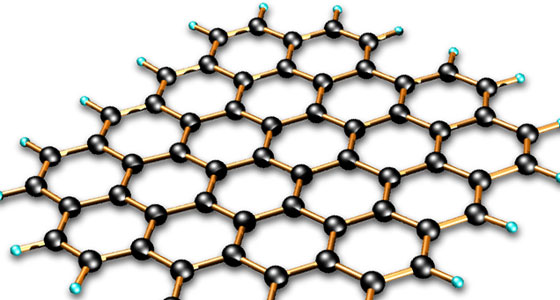Graphene is a particular form of pure carbon, with a honeycomb structure and a thickness of a single atom

Researchers from MIT University announced at the conference of the American Physical Society, which took place in March 2009, that a new material called graphene (Graphene) may pave the way for the production of processors that will operate at a clock speed of 500 to 1,000 GHz. The full findings of the study will be published in the May issue of the journal Electron Device Letters.
The material in question is a particular form of pure carbon, with a honeycomb structure and a thickness of a single atom. It was discovered in 2004, and since then scientists from various research institutions have tested what uses can be made of it. Thomas Palacios, a lecturer in MIT's Department of Electrical Engineering and Computer Science and one of the researchers, estimated that the material will play an important role in future chips. Together with Jing Kong, another lecturer in MIT's Department of Electrical Engineering and Computer Science, and students Han Wong and Daniel Nezich, Palacios created an experimental chip from Graphene, which is capable of doubling the frequency of electrical signals.
The researchers explained that the technology currently used to double the speed creates interference, requires filtering and increases electricity consumption. The chip made of Graphene includes only one transistor, does not create interference and saves the need for a filter. According to Palacios, the technology could be available for commercial application in a year or two. In the next step, the researchers intend to develop methods for the production of larger graphene sheets.

16 תגובות
It's funny to me that it's made of carbon, now there will really be a competition between biology and technology!
I agree that Moore's Law is primarily an economic law.
It makes no economic sense to market a new product at the expense of surpluses of an old product whose production costs you have not yet covered.
HW his honor in his place rests…. XS and ANANDTECH and THG and VRZONE are a bit more worldly and respectable... check there.
When will the Israelis learn to say "giga" instead of "giga"? The only country in the world where it is pronounced as giga, and you have no idea how jarring that is.
from here
http://hwzone.co.il/news/1165044158/86355/
Don't know where you got that from but two years ago there were only 65NM processors.
The Q6600 of sorts.
age
The quad series processors with 4 cores that were sold at least two and a half years ago and are still being sold are also 45 nanometers.
I know this industry and you are 100% right. The technology is not progressing as quickly as possible because of the limitation of return on investment at the break-even point and of course generating profits after that from these technologies.
Not so true period.
Intel could not produce 45NM processors a few years ago (45 is the I7)
It was not technologically possible to do so.
Moore's Law is an economic law, designed to maintain a constant profit factor for companies.
For example, from a technological point of view, Intel could produce the processors with their technology today already a few years ago.
Does this mean that Moore's Law will continue with us in the years to come?
It is true that all this is practical, but in order for it to reach commercial production, factories with suitable technology are needed and it will take many more years to develop and build... In the meantime, only the army (probably not ours - it needs a lot of money) will benefit from it...
Point: I didn't understand what you meant by "it's enough to note...", what does it mean that it's the size of a cm and how does it affect?
Higher frequencies will require completely different technology.
Suffice it to note that the distance that an electrical signal travels in a processor with a frequency of 3GHZ (half a clock is 6GHZ) is on the order of a centimeter and this is the order of magnitude of a processor.
It's not that in two years there will be a 1THZ processor for sale on Zap.
A computer processor is something more complex than a transistor.
A computer processor contains millions of transistors…
Regarding works (research) if this type of material has already been discussed and there were several articles even 3-4 years ago.
Interesting, but they will back up a company from INTEL, AMD, IBM, TI, MOTOROLA, etc...
That means 500-250 times faster than an average 2 GHz processor.
And all this in a year or two? Sounds too good to be true.